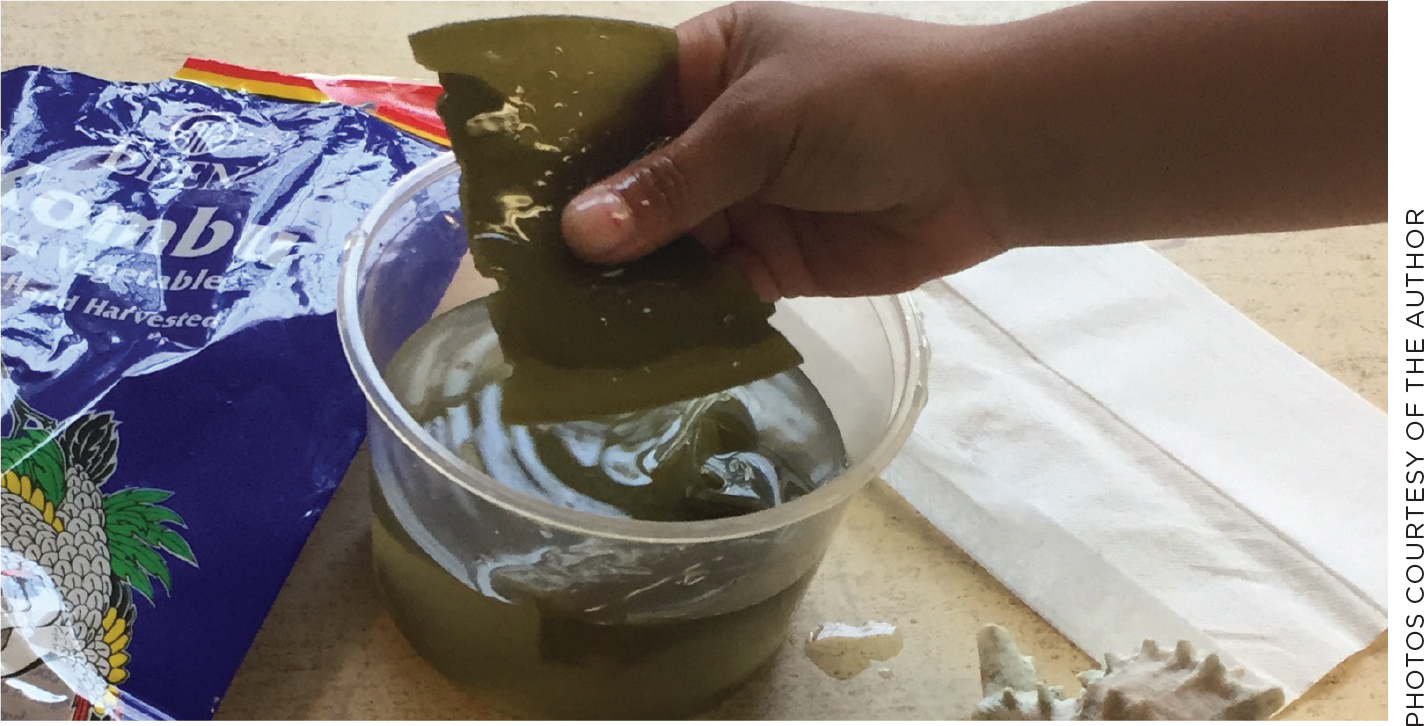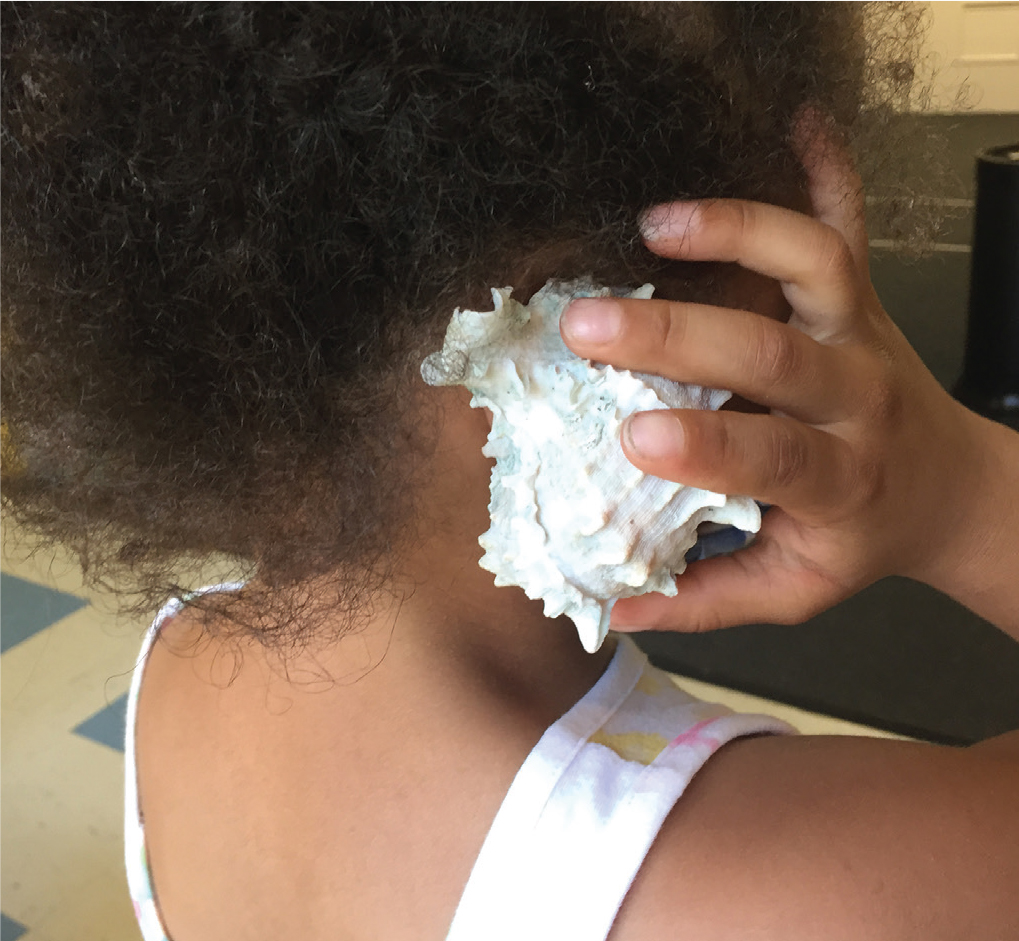The Early Years
Virtual and Sensory Experiences
Science and Children—September/October 2020 (Volume 58, Issue 1)
By Peggy Ashbrook

Examining seaweed evokes the seaside.
When funding or opportunities for field trips decline, creative early childhood educators turn to walking field trips to enhance their students’ experience with the world outside the classroom. If walking to a nearby area is out of reach, taking virtual field trips through video calls and live camera feeds becomes an option.
A virtual field trip may happen through video calls to classrooms in other schools or countries to see their room and projects. Video calls with family members can share the sounds and sights of their garden, cooking project, music making, or their work in construction or science. We can learn about places and animals from live camera feeds (see NSTA Connection), but we will still be missing the feel of the wind, humidity, and sunlight, and smells and the directionality of sounds. Virtually revisiting the places and spaces the children have previously visited first-hand prompts children to recall their prior experience and describe their sensory memories.
Children’s prior experiences and imaginations can fill in the smells and tastes and sometimes sounds that are missing from video. When taking a “field trip,” ask children to describe what they think they might smell and feel if they were there in person. Without prior experience, children’s ideas may be unlikely but still reveal their understanding of sensations missing from virtual experiences.
Books that fully evoke a particular place or sensory experience can model how to add sensory descriptions to support images or other media children create. Read the book aloud in person or on a video call, or use a previously published video reading of the book. Help children create a virtual field trip about an experience they want to share using drawing/writing materials, play dough, collage, dioramas, camera, audio recorder, or apps for documentation and storytelling, with the support of adults. To add memorable or favorite sensory experiences expanding the media they create, children may record or link to sounds (bird song or street sounds), make collages of textures (petting a kitten), or mimic the feeling of touching snow (shaved ice). Use the resources in the suggested Wakelet, a platform where content is curated and saved for sharing, to support digital media creation.
A visit with the family pet, view of their Lego structure, a walk up their street, or a moment in nature observing a bird or incoming weather system are all possibilities for children’s media documentation with written or audio recorded commentary describing the missing sensations.
Resources
NAEYC Technology and Young Children Interest Forum. Children and Families as Digital Creators and Storytellers: Learning with/from young children and their families. https://wke.lt/w/s/7ELzSR
- Book with a sensory description of a beach setting (see Resources)
- Virtual beach field trip (see NSTA Connection)
- Foot-size container of warm, damp sand
- 3/4 teaspoon of table salt
- 1 cup of water
- 1 spoon for every child
- Dried kombu or wakame seaweed softened in a bowl of water
- Large marine snail shell
Virtual Beach Trip
Objective
Children will have sensory experiences that recall a visit to a beach or supplement a virtual beach field trip.
- Read one of the suggested books or view a virtual field trip about a beach environment, or choose one about another setting. Stop mid-reading or viewing and ask children to recall any beach experiences and what they sensed using sight, touch, smell, taste, and hearing. Finish reading or viewing the media.
- Be inspired by children’s memories of sensory experiences to recreate them if possible, although at a much smaller scale. Ask children to suggest ways to have those sensations although not at a beach, such as listening to an audio recording of herring gulls (The Cornell Lab). The experiences can directly follow the reading or happen later, at school or at home if part of supported home learning.
- Children may recall the feeling of sand under their toes and want to step into sand with bare feet. Provide a container of warm, damp sand. Warm the sand by using warm water to wet it, or very briefly microwave the damp sand and stir it thoroughly before use to even out hot spots.
- If children recall the taste of the ocean water, make a salt water solution to approximate ocean water’s 3.5 percent salt by weight. Add 3/4 teaspoon of table salt to 1 cup of water and have children help stir to dissolve it. Tasting salt water can be experienced by licking individual spoons dipped in the lightly salted water.
- Mimic the smell of the ocean using dried kombu or wakame edible seaweed softened for 10 minutes in a bowl of warm water. Pass each child a piece of the now wet seaweed. Be prepared for some to find the texture disgusting and others asking to eat it.
- Many children hold the delightful misconception that there is a small ocean inside large marine snail shells, heard when held to the ear. The idea that the sound is made by tiny waves can be discouraged by having children hold a small open cup over their ear and hearing the same sound. Wonder aloud, “I wonder what does make that sound?” to allow children to consider alternative explanations.
An ocean beach environment is only one of many experiences richly described in books that children may wish to create or re-experience. How might they represent the sensations of standing in a rain downpour, walking through a mud puddle, climbing up an apartment building stairwell in the evening passing door after door smelling scents of dinner, or strapping in and blasting off for the Moon?

Listen!
Resources
The Cornell Lab. All About Birds, Herring Gulls. https://www.allaboutbirds.org/guide/Herring_Gull/sounds
Books that describe an ocean beach
Frasier, D. 1998. Out of the ocean. San Diego: Harcourt.
Pringle, L. 2003. Come to the ocean’s edge. Honesdale, PA: Boyds Mills Press.
Rotner, S. 1993. Ocean day. New York: Macmillan.
Rotner, Shelley. 2010. Senses at the Seashore. Minneapolis, MN: Millbrook. (Muskingum County Library System, Senses at the Seashore read aloud video: https://www.youtube.com/watch?v=vETuKvY9IGQ
Ryan, P.M. 2001. Hello ocean / Hola mar. Watertown, MA: Charlesbridge.
Peggy Ashbrook (scienceissimple@yahoo.com) is the author of Science Learning in the Early Years: Activities in PreK–2 and teaches preschool science in Alexandria, Virginia.
Environmental Science Life Science Technology Early Childhood Elementary


